child seat SKODA ROOMSTER 2009 1.G User Guide
[x] Cancel search | Manufacturer: SKODA, Model Year: 2009, Model line: ROOMSTER, Model: SKODA ROOMSTER 2009 1.GPages: 263, PDF Size: 32.25 MB
Page 133 of 263
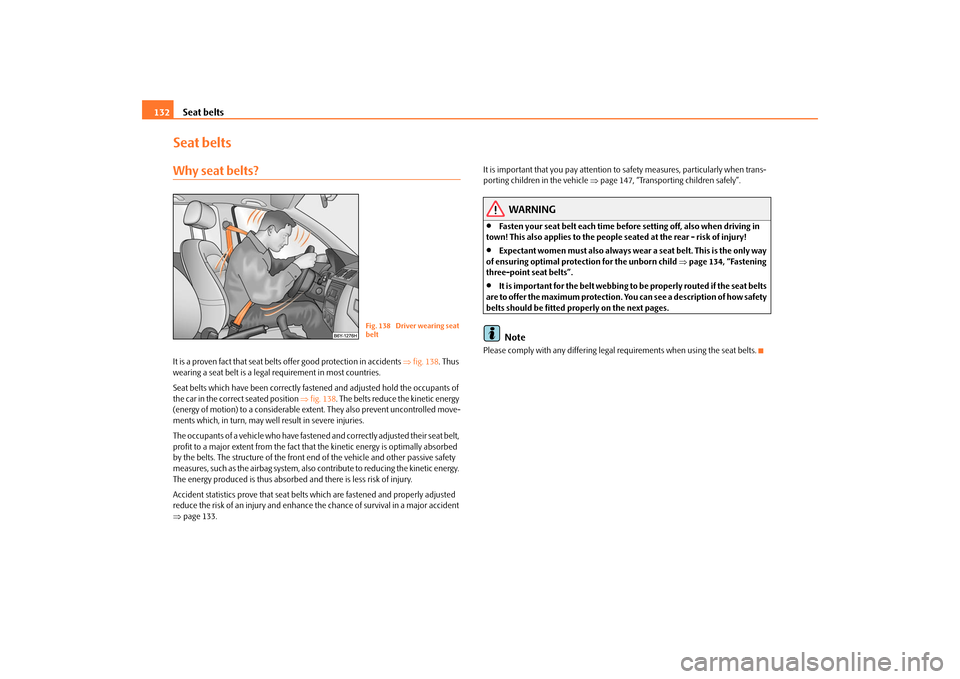
Seat belts 132Seat beltsWhy seat belts?It is a proven fact that seat belts offer good protection in accidents ⇒fig. 138. Thus
wearing a seat belt is a legal requirement in most countries.
Seat belts which have been correctly fastened and adjusted hold the occupants of
the car in the correct seated position ⇒fig. 138. The belts reduce the kinetic energy
(energy of motion) to a considerable extent. They also prevent uncontrolled move-
ments which, in turn, may well result in severe injuries.
The occupants of a vehicle who have fastened and correctly adjusted their seat belt,
profit to a major extent from the fact that the kinetic energy is optimally absorbed
by the belts. The structure of the front end of the vehicle and other passive safety
measures, such as the airbag system, also contribute to reducing the kinetic energy.
The energy produced is thus absorbed and there is less risk of injury.
Accident statistics prove that seat belts which are fastened and properly adjusted
reduce the risk of an injury and enhance the chance of survival in a major accident
⇒page 133.It is important that you pay attention to safety measures, particularly when trans-
porting children in the vehicle ⇒page 147, “Transporting children safely”.
WARNING
•
Fasten your seat belt each time before setting off, also when driving in
town! This also applies to the people seated at the rear - risk of injury!
•
Expectant women must also always wear a seat belt. This is the only way
of ensuring optimal protection for the unborn child ⇒page 134, “Fastening
three-point seat belts”.
•
It is important for the belt webbing to be properly routed if the seat belts
are to offer the maximum protection. You can see a description of how safety
belts should be fitted properly on the next pages.Note
Please comply with any differing legal requirements when using the seat belts.
Fig. 138 Driver wearing seat
belt
s29g.4.book Page 132 Wednesday, June 17, 2009 9:54 AM
Page 135 of 263
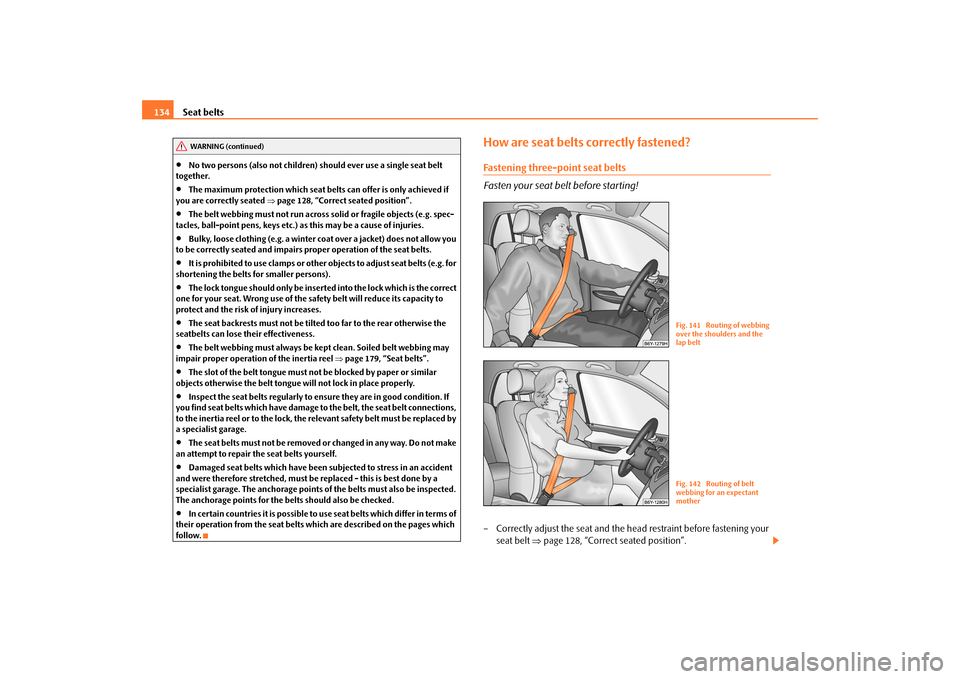
Seat belts 134•
No two persons (also not children) should ever use a single seat belt
together.
•
The maximum protection which seat belts can offer is only achieved if
you are correctly seated ⇒page 128, “Correct seated position”.
•
The belt webbing must not run across solid or fragile objects (e.g. spec-
tacles, ball-point pens, keys etc.) as this may be a cause of injuries.
•
Bulky, loose clothing (e.g. a winter coat over a jacket) does not allow you
to be correctly seated and impairs proper operation of the seat belts.
•
It is prohibited to use clamps or other objects to adjust seat belts (e.g. for
shortening the belts for smaller persons).
•
The lock tongue should only be inserted into the lock which is the correct
one for your seat. Wrong use of the safety belt will reduce its capacity to
protect and the risk of injury increases.
•
The seat backrests must not be tilted too far to the rear otherwise the
seatbelts can lose their effectiveness.
•
The belt webbing must always be kept clean. Soiled belt webbing may
impair proper operation of the inertia reel ⇒page 179, “Seat belts”.
•
The slot of the belt tongue must not be blocked by paper or similar
objects otherwise the belt tongue will not lock in place properly.
•
Inspect the seat belts regularly to ensure they are in good condition. If
you find seat belts which have damage to the belt, the seat belt connections,
to the inertia reel or to the lock, the relevant safety belt must be replaced by
a specialist garage.
•
The seat belts must not be removed or changed in any way. Do not make
an attempt to repair the seat belts yourself.
•
Damaged seat belts which have been subjected to stress in an accident
and were therefore stretched, must be replaced - this is best done by a
specialist garage. The anchorage points of the belts must also be inspected.
The anchorage points for the belts should also be checked.
•
In certain countries it is possible to use seat belts which differ in terms of
their operation from the seat belts which are described on the pages which
follow.
How are seat belts correctly fastened?Fastening three-point seat belts
Fasten your seat belt before starting!– Correctly adjust the seat and the head restraint before fastening your
seat belt ⇒page 128, “Correct seated position”.
WARNING (continued)
Fig. 141 Routing of webbing
over the shoulders and the
lap beltFig. 142 Routing of belt
webbing for an expectant
mother
s29g.4.book Page 134 Wednesday, June 17, 2009 9:54 AM
Page 142 of 263
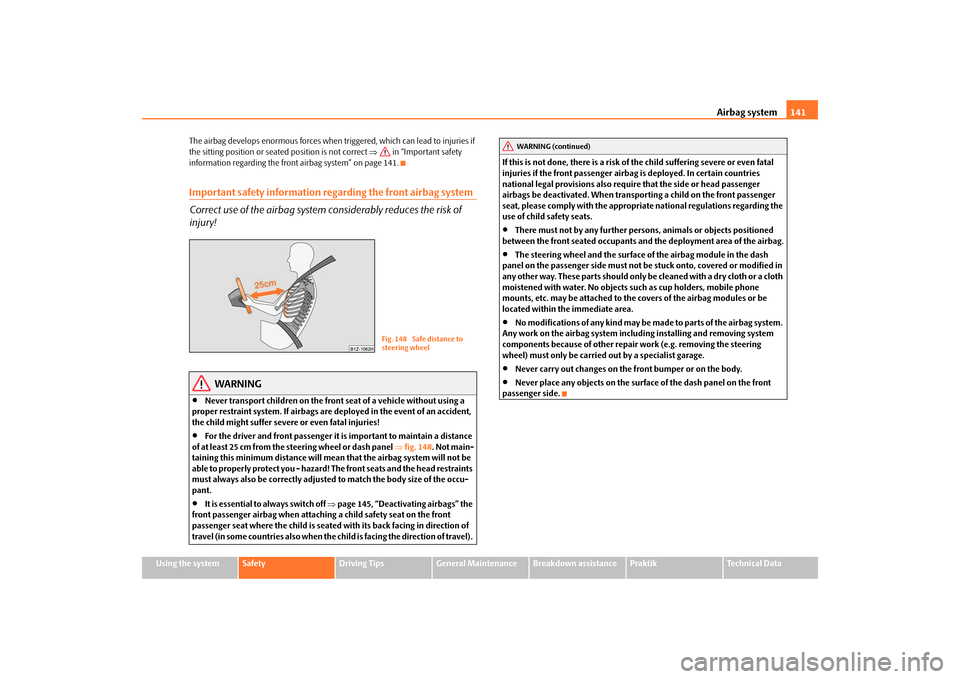
Airbag system141
Using the system
Safety
Driving Tips
General Maintenance
Breakdown assistance
Praktik
Technical Data The airbag develops enormous forces when triggered, which can lead to injuries if
the sitting position or seated position is not correct ⇒ in “Important safety
information regarding the front airbag system” on page 141.
Important safety information regarding the front airbag system
Correct use of the airbag system considerably reduces the risk of
injury!
WARNING
•
Never transport children on the front seat of a vehicle without using a
proper restraint system. If airbags are deployed in the event of an accident,
the child might suffer severe or even fatal injuries!
•
For the driver and front passenger it is important to maintain a distance
of at least 25 cm from the steering wheel or dash panel ⇒fig. 148. Not main-
taining this minimum distance will mean that the airbag system will not be
able to properly protect you - hazard! The front seats and the head restraints
must always also be correctly adjusted to match the body size of the occu-
pant.
•
It is essential to always switch off ⇒page 145, “Deactivating airbags” the
front passenger airbag when attaching a child safety seat on the front
passenger seat where the child is seated with its back facing in direction of
travel (in some countries also when the child is facing the direction of travel). If this is not done, there is a risk of the child suffering severe or even fatal
injuries if the front passenger airbag is deployed. In certain countries
national legal provisions also require that the side or head passenger
airbags be deactivated. When transporting a child on the front passenger
seat, please comply with the appropriate national regulations regarding the
use of child safety seats.
•
There must not by any further persons, animals or objects positioned
between the front seated occupants and the deployment area of the airbag.
•
The steering wheel and the surface of the airbag module in the dash
panel on the passenger side must not be stuck onto, covered or modified in
any other way. These parts should only be cleaned with a dry cloth or a cloth
moistened with water. No objects such as cup holders, mobile phone
mounts, etc. may be attached to the covers of the airbag modules or be
located within the immediate area.
•
No modifications of any kind may be made to parts of the airbag system.
Any work on the airbag system including installing and removing system
components because of other repair work (e.g. removing the steering
wheel) must only be carried out by a specialist garage.
•
Never carry out changes on the front bumper or on the body.
•
Never place any objects on the surface of the dash panel on the front
passenger side.
Fig. 148 Safe distance to
steering wheel
WARNING (continued)
s29g.4.book Page 141 Wednesday, June 17, 2009 9:54 AM
Page 144 of 263
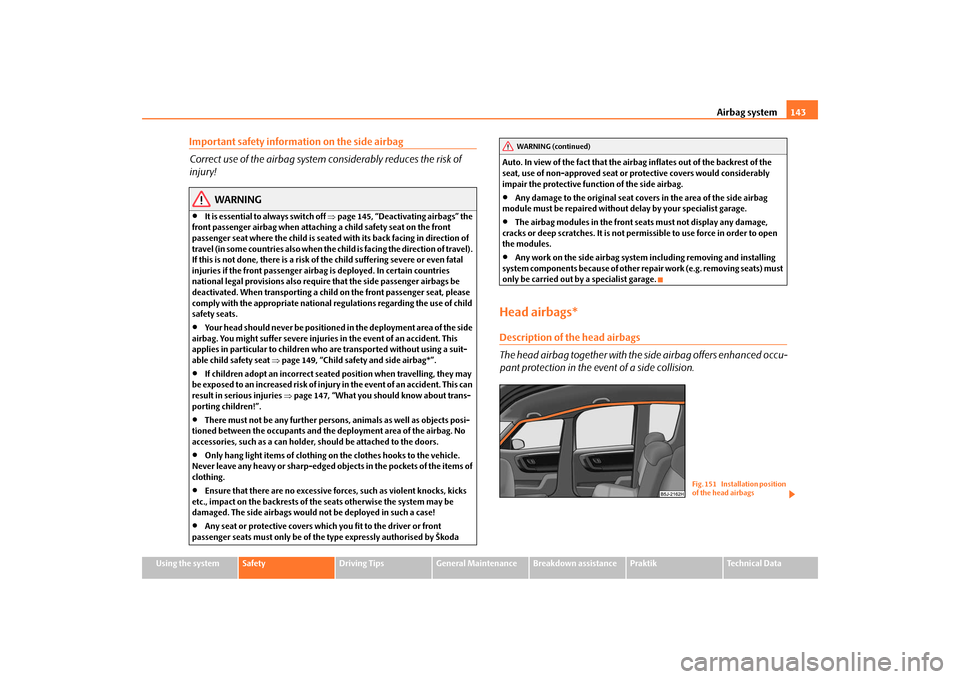
Airbag system143
Using the system
Safety
Driving Tips
General Maintenance
Breakdown assistance
Praktik
Technical Data
Important safety information on the side airbag
Correct use of the airbag system considerably reduces the risk of
injury!
WARNING
•
It is essential to always switch off ⇒page 145, “Deactivating airbags” the
front passenger airbag when attaching a child safety seat on the front
passenger seat where the child is seated with its back facing in direction of
travel (in some countries also when the child is facing the direction of travel).
If this is not done, there is a risk of the child suffering severe or even fatal
injuries if the front passenger airbag is deployed. In certain countries
national legal provisions also require that the side passenger airbags be
deactivated. When transporting a child on the front passenger seat, please
comply with the appropriate national regulations regarding the use of child
safety seats.
•
Your head should never be positioned in the deployment area of the side
airbag. You might suffer severe injuries in the event of an accident. This
applies in particular to children who are transported without using a suit-
able child safety seat ⇒page 149, “Child safety and side airbag*”.
•
If children adopt an incorrect seated position when travelling, they may
be exposed to an increased risk of injury in the event of an accident. This can
result in serious injuries ⇒page 147, “What you should know about trans-
porting children!”.
•
There must not be any further persons, animals as well as objects posi-
tioned between the occupants and the deployment area of the airbag. No
accessories, such as a can holder, should be attached to the doors.
•
Only hang light items of clothing on the clothes hooks to the vehicle.
Never leave any heavy or sharp-edged objects in the pockets of the items of
clothing.
•
Ensure that there are no excessive forces, such as violent knocks, kicks
etc., impact on the backrests of the seats otherwise the system may be
damaged. The side airbags would not be deployed in such a case!
•
Any seat or protective covers which you fit to the driver or front
passenger seats must only be of the type expressly authorised by Škoda Auto. In view of the fact that the airbag inflates out of the backrest of the
seat, use of non-approved seat or protective covers would considerably
impair the protective function of the side airbag.
•
Any damage to the original seat covers in the area of the side airbag
module must be repaired without delay by your specialist garage.
•
The airbag modules in the front seats must not display any damage,
cracks or deep scratches. It is not permissible to use force in order to open
the modules.
•
Any work on the side airbag system including removing and installing
system components because of other repair work (e.g. removing seats) must
only be carried out by a specialist garage.
Head airbags*Description of the head airbags
The head airbag together with the side airbag offers enhanced occu-
pant protection in the event of a side collision.
WARNING (continued)
Fig. 151 Installation position
of the head airbags
s29g.4.book Page 143 Wednesday, June 17, 2009 9:54 AM
Page 145 of 263
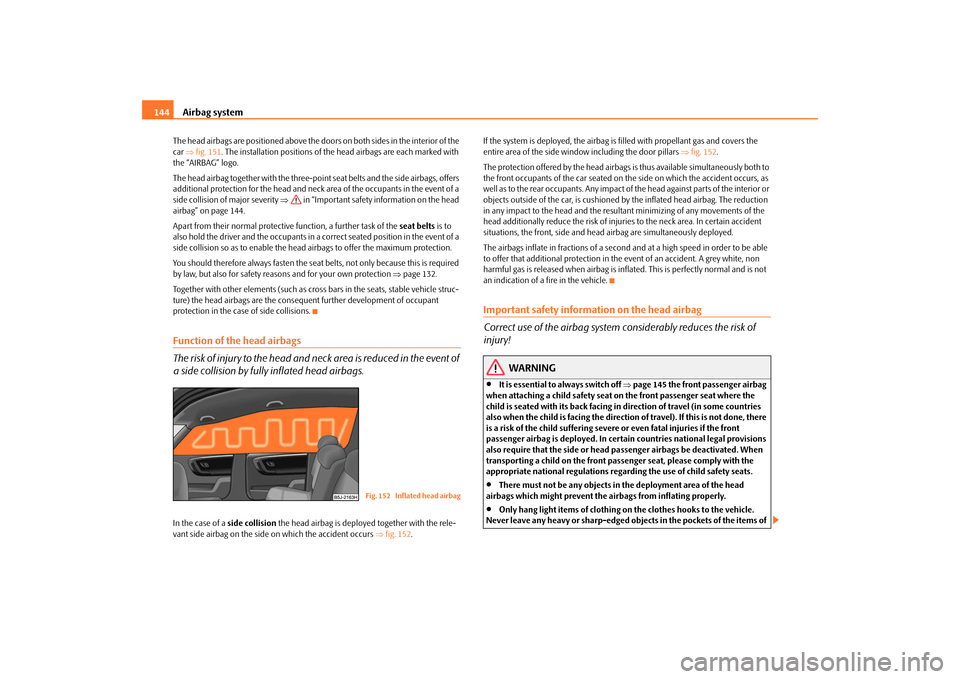
Airbag system 144The head airbags are positioned above the doors on both sides in the interior of the
car ⇒fig. 151. The installation positions of the head airbags are each marked with
the “AIRBAG” logo.
The head airbag together with the three-point seat belts and the side airbags, offers
additional protection for the head and neck area of the occupants in the event of a
side collision of major severity ⇒ in “Important safety information on the head
airbag” on page 144.
Apart from their normal protective function, a further task of the seat belts is to
also hold the driver and the occupants in a correct seated position in the event of a
side collision so as to enable the head airbags to offer the maximum protection.
You should therefore always fasten the seat belts, not only because this is required
by law, but also for safety reasons and for your own protection ⇒page 132.
Together with other elements (such as cross bars in the seats, stable vehicle struc-
ture) the head airbags are the consequent further development of occupant
protection in the case of side collisions.Function of the head airbags
The risk of injury to the head and neck area is reduced in the event of
a side collision by fully inflated head airbags.In the case of a side collision the head airbag is deployed together with the rele-
vant side airbag on the side on which the accident occurs ⇒fig. 152.If the system is deployed, the airbag is filled with propellant gas and covers the
entire area of the side window including the door pillars ⇒fig. 152.
The protection offered by the head airbags is thus available simultaneously both to
the front occupants of the car seated on the side on which the accident occurs, as
well as to the rear occupants. Any impact of the head against par ts of the interior or
objects outside of the car, is cushioned by the inflated head airbag. The reduction
in any impact to the head and the resultant minimizing of any movements of the
head additionally reduce the risk of injuries to the neck area. In certain accident
situations, the front, side and head airbag are simultaneously deployed.
The airbags inflate in fractions of a second and at a high speed in order to be able
to offer that additional protection in the event of an accident. A grey white, non
harmful gas is released when airbag is inflated. This is perfectly normal and is not
an indication of a fire in the vehicle.
Important safety information on the head airbag
Correct use of the airbag system considerably reduces the risk of
injury!
WARNING
•
It is essential to always switch off ⇒page 145 the front passenger airbag
when attaching a child safety seat on the front passenger seat where the
child is seated with its back facing in direction of travel (in some countries
also when the child is facing the direction of travel). If this is not done, there
is a risk of the child suffering severe or even fatal injuries if the front
passenger airbag is deployed. In certain countries national legal provisions
also require that the side or head passenger airbags be deactivated. When
transporting a child on the front passenger seat, please comply with the
appropriate national regulations regarding the use of child safety seats.
•
There must not be any objects in the deployment area of the head
airbags which might prevent the airbags from inflating properly.
•
Only hang light items of clothing on the clothes hooks to the vehicle.
Never leave any heavy or sharp-edged objects in the pockets of the items of
Fig. 152 Inflated head airbag
s29g.4.book Page 144 Wednesday, June 17, 2009 9:54 AM
Page 146 of 263
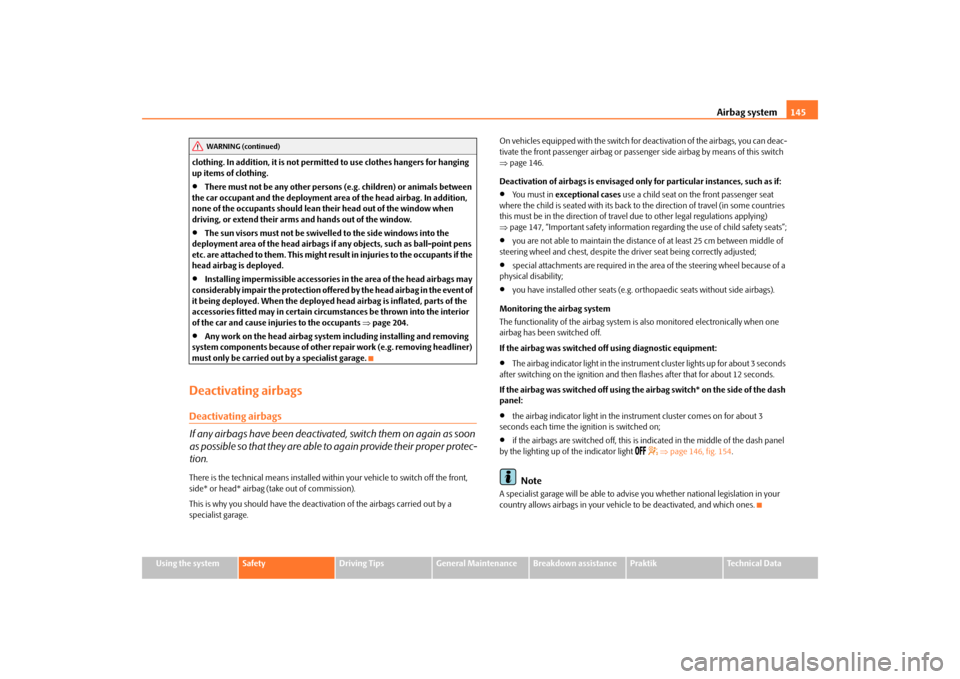
Airbag system145
Using the system
Safety
Driving Tips
General Maintenance
Breakdown assistance
Praktik
Technical Data clothing. In addition, it is not permitted to use clothes hangers for hanging
up items of clothing.
•
There must not be any other persons (e.g. children) or animals between
the car occupant and the deployment area of the head airbag. In addition,
none of the occupants should lean their head out of the window when
driving, or extend their arms and hands out of the window.
•
The sun visors must not be swivelled to the side windows into the
deployment area of the head airbags if any objects, such as ball-point pens
etc. are attached to them. This might result in injuries to the occupants if the
head airbag is deployed.
•
Installing impermissible accessories in the area of the head airbags may
considerably impair the protection offered by the head airbag in the event of
it being deployed. When the deployed head airbag is inflated, parts of the
accessories fitted may in certain circumstances be thrown into the interior
of the car and cause injuries to the occupants ⇒page 204.
•
Any work on the head airbag system including installing and removing
system components because of other repair work (e.g. removing headliner)
must only be carried out by a specialist garage.
Deactivating airbagsDeactivating airbags
If any airbags have been deactivated, switch them on again as soon
as possible so that they are able to again provide their proper protec-
tion.There is the technical means installed within your vehicle to switch off the front,
side* or head* airbag (take out of commission).
This is why you should have the deactivation of the airbags carried out by a
specialist garage.On vehicles equipped with the switch for deactivation of the airbags, you can deac-
tivate the front passenger airbag or passenger side airbag by means of this switch
⇒page 146.
Deactivation of airbags is envisaged only for particular instances, such as if:
•
You must in exceptional cases use a child seat on the front passenger seat
where the child is seated with its back to the direction of travel (in some countries
this must be in the direction of travel due to other legal regulations applying)
⇒page 147, “Important safety information regarding the use of child safety seats”;
•
you are not able to maintain the distance of at least 25 cm between middle of
steering wheel and chest, despite the driver seat being correctly adjusted;
•
special attachments are required in the area of the steering wheel because of a
physical disability;
•
you have installed other seats (e.g. orthopaedic seats without side airbags).
Monitoring the airbag system
The functionality of the airbag system is also monitored electronically when one
airbag has been switched off.
If the airbag was switched off using diagnostic equipment:
•
The airbag indicator light in the instrument cluster lights up for about 3 seconds
after switching on the ignition and then flashes after that for about 12 seconds.
If the airbag was switched off using the airbag switch* on the side of the dash
panel:
•
the airbag indicator light in the instrument cluster comes on for about 3
seconds each time the ignition is switched on;
•
if the airbags are switched off, this is indicated in the middle of the dash panel
by the lighting up of the indicator light
⇒page 146, fig. 154.
Note
A specialist garage will be able to advise you whether national legislation in your
country allows airbags in your vehicle to be deactivated, and which ones.
WARNING (continued)
s29g.4.book Page 145 Wednesday, June 17, 2009 9:54 AM
Page 148 of 263
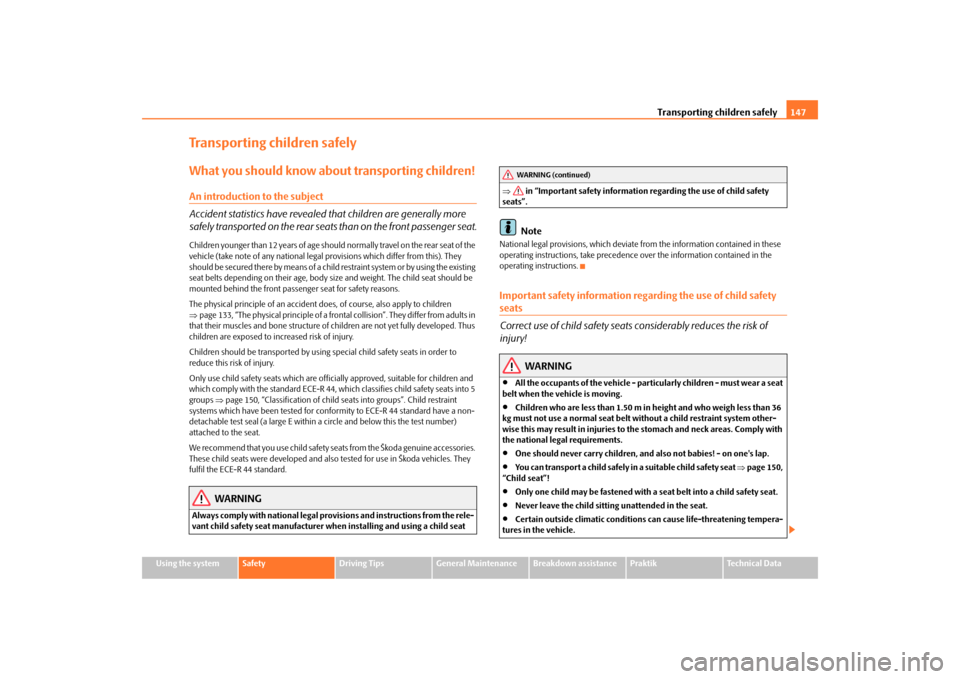
Transporting children safely147
Using the system
Safety
Driving Tips
General Maintenance
Breakdown assistance
Praktik
Technical Data
Transporting children safelyWhat you should know about transporting children!An introduction to the subject
Accident statistics have revealed that children are generally more
safely transported on the rear seats than on the front passenger seat.Children younger than 12 years of age should normally travel on the rear seat of the
vehicle (take note of any national legal provisions which differ from this). They
should be secured there by means of a child restraint system or by using the existing
seat belts depending on their age, body size and weight. The child seat should be
mounted behind the front passenger seat for safety reasons.
The physical principle of an accident does, of course, also apply to children
⇒page 133, “The physical principle of a frontal collision”. They differ from adults in
that their muscles and bone structure of children are not yet fully developed. Thus
children are exposed to increased risk of injury.
Children should be transported by using special child safety seats in order to
reduce this risk of injury.
Only use child safety seats which are officially approved, suitable for children and
which comply with the standard ECE-R 44, which classifies child safety seats into 5
groups ⇒page 150, “Classification of child seats into groups”. Child restraint
systems which have been tested for conformity to ECE-R 44 standard have a non-
detachable test seal (a large E within a circle and below this the test number)
attached to the seat.
We recommend that you use child safety seats from the Škoda genuine accessories.
These child seats were developed and also tested for use in Škoda vehicles. They
fulfil the ECE-R 44 standard.
WARNING
Always comply with national legal provisions and instructions from the rele-
vant child safety seat manufacturer when installing and using a child seat ⇒ in “Important safety information regarding the use of child safety
seats”.
Note
National legal provisions, which deviate from the information contained in these
operating instructions, take precedence over the information contained in the
operating instructions.Important safety information regarding the use of child safety seats
Correct use of child safety seats considerably reduces the risk of
injury!
WARNING
•
All the occupants of the vehicle - particularly children - must wear a seat
belt when the vehicle is moving.
•
Children who are less than 1.50 m in height and who weigh less than 36
kg must not use a normal seat belt without a child restraint system other-
wise this may result in injuries to the stomach and neck areas. Comply with
the national legal requirements.
•
One should never carry children, and also not babies! - on one's lap.
•
You can transport a child safely in a suitable child safety seat ⇒page 150,
“Child seat”!
•
Only one child may be fastened with a seat belt into a child safety seat.
•
Never leave the child sitting unattended in the seat.
•
Certain outside climatic conditions can cause life-threatening tempera-
tures in the vehicle.WARNING (continued)
s29g.4.book Page 147 Wednesday, June 17, 2009 9:54 AM
Page 149 of 263
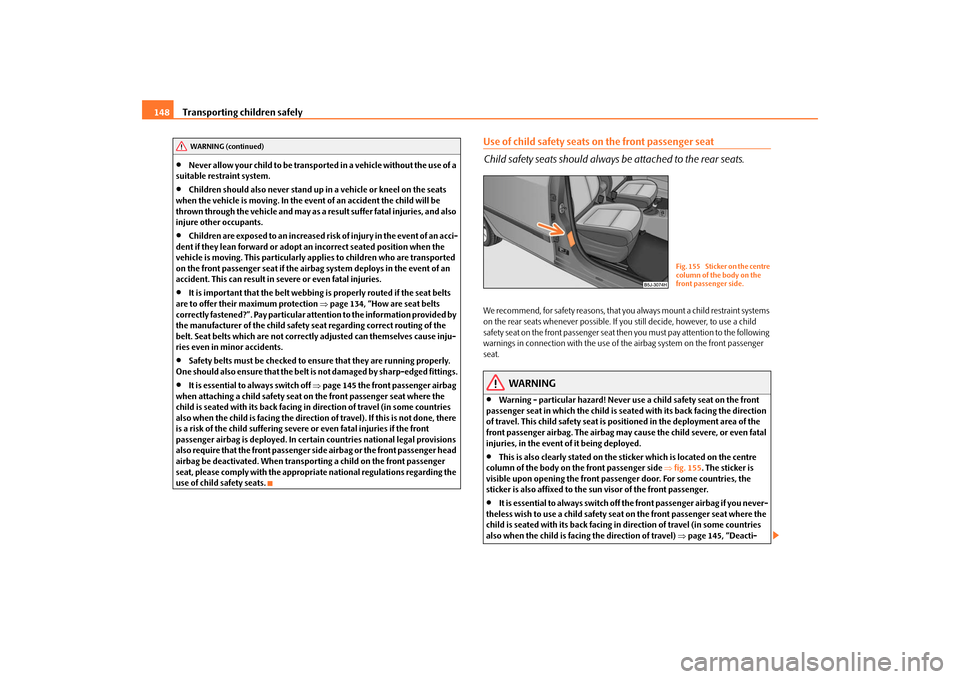
Transporting children safely 148•
Never allow your child to be transported in a vehicle without the use of a
suitable restraint system.
•
Children should also never stand up in a vehicle or kneel on the seats
when the vehicle is moving. In the event of an accident the child will be
thrown through the vehicle and may as a result suffer fatal injuries, and also
injure other occupants.
•
Children are exposed to an increased risk of injury in the event of an acci-
dent if they lean forward or adopt an incorrect seated position when the
vehicle is moving. This particularly applies to children who are transported
on the front passenger seat if the airbag system deploys in the event of an
accident. This can result in severe or even fatal injuries.
•
It is important that the belt webbing is properly routed if the seat belts
are to offer their maximum protection ⇒page 134, “How are seat belts
correctly fastened?”. Pay particular attention to the information provided by
the manufacturer of the child safety seat regarding correct routing of the
belt. Seat belts which are not correctly adjusted can themselves cause inju-
ries even in minor accidents.
•
Safety belts must be checked to ensure that they are running properly.
One should also ensure that the belt is not damaged by sharp-edged fittings.
•
It is essential to always switch off ⇒page 145 the front passenger airbag
when attaching a child safety seat on the front passenger seat where the
child is seated with its back facing in direction of travel (in some countries
also when the child is facing the direction of travel). If this is not done, there
is a risk of the child suffering severe or even fatal injuries if the front
passenger airbag is deployed. In certain countries national legal provisions
also require that the front passenger side airbag or the front passenger head
airbag be deactivated. When transporting a child on the front passenger
seat, please comply with the appropriate national regulations regarding the
use of child safety seats.
Use of child safety seats on the front passenger seat
Child safety seats should always be attached to the rear seats.We recommend, for safety reasons, that you always mount a child restraint systems
on the rear seats whenever possible. If you still decide, however, to use a child
safety seat on the front passenger seat then you must pay attention to the following
warnings in connection with the use of the airbag system on the front passenger
seat.
WARNING
•
Warning - particular hazard! Never use a child safety seat on the front
passenger seat in which the child is seated with its back facing the direction
of travel. This child safety seat is positioned in the deployment area of the
front passenger airbag. The airbag may cause the child severe, or even fatal
injuries, in the event of it being deployed.
•
This is also clearly stated on the sticker which is located on the centre
column of the body on the front passenger side ⇒fig. 155. The sticker is
visible upon opening the front passenger door. For some countries, the
sticker is also affixed to the sun visor of the front passenger.
•
It is essential to always switch off the front passenger airbag if you never-
theless wish to use a child safety seat on the front passenger seat where the
child is seated with its back facing in direction of travel (in some countries
also when the child is facing the direction of travel) ⇒page 145, “Deacti-
WARNING (continued)
Fig. 155 Sticker on the centre
column of the body on the
front passenger side.
s29g.4.book Page 148 Wednesday, June 17, 2009 9:54 AM
Page 150 of 263
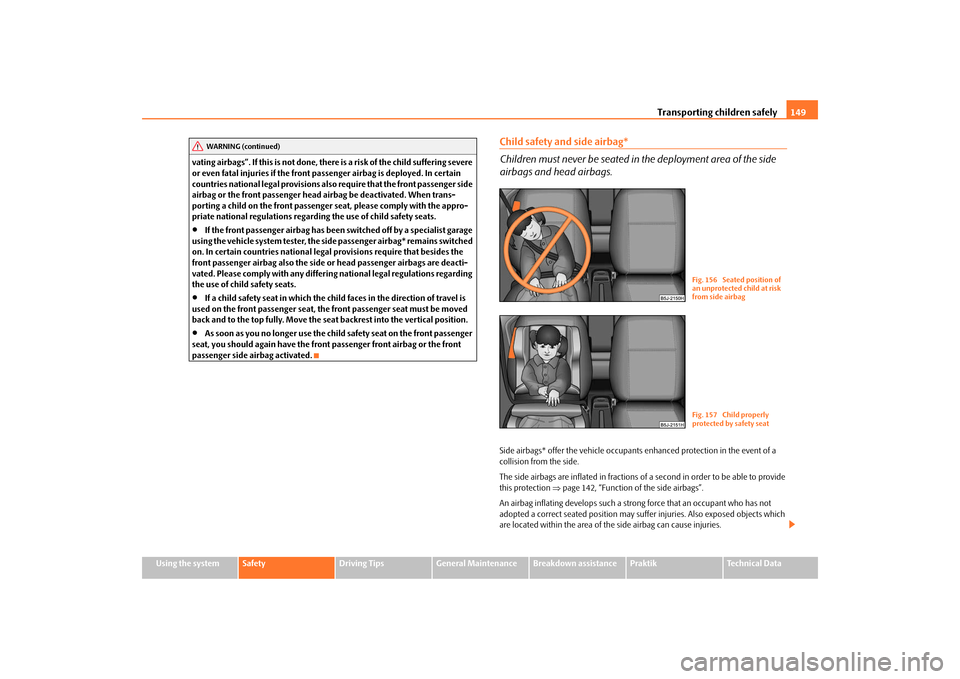
Transporting children safely149
Using the system
Safety
Driving Tips
General Maintenance
Breakdown assistance
Praktik
Technical Data vating airbags”. If this is not done, there is a risk of the child suffering severe
or even fatal injuries if the front passenger airbag is deployed. In certain
countries national legal provisions also require that the front passenger side
airbag or the front passenger head airbag be deactivated. When trans-
porting a child on the front passenger seat, please comply with the appro-
priate national regulations regarding the use of child safety seats.
•
If the front passenger airbag has been switched off by a specialist garage
using the vehicle system tester, the side passenger airbag* remains switched
on. In certain countries national legal provisions require that besides the
front passenger airbag also the side or head passenger airbags are deacti-
vated. Please comply with any differing national legal regulations regarding
the use of child safety seats.
•
If a child safety seat in which the child faces in the direction of travel is
used on the front passenger seat, the front passenger seat must be moved
back and to the top fully. Move the seat backrest into the vertical position.
•
As soon as you no longer use the child safety seat on the front passenger
seat, you should again have the front passenger front airbag or the front
passenger side airbag activated.
Child safety and side airbag*
Children must never be seated in the deployment area of the side
airbags and head airbags.Side airbags* offer the vehicle occupants enhanced protection in the event of a
collision from the side.
The side airbags are inflated in fractions of a second in order to be able to provide
this protection ⇒page 142, “Function of the side airbags”.
An airbag inflating develops such a strong force that an occupant who has not
adopted a correct seated position may suffer injuries. Also exposed objects which
are located within the area of the side airbag can cause injuries.
WARNING (continued)
Fig. 156 Seated position of
an unprotected child at risk
from side airbagFig. 157 Child properly
protected by safety seat
s29g.4.book Page 149 Wednesday, June 17, 2009 9:54 AM
Page 151 of 263
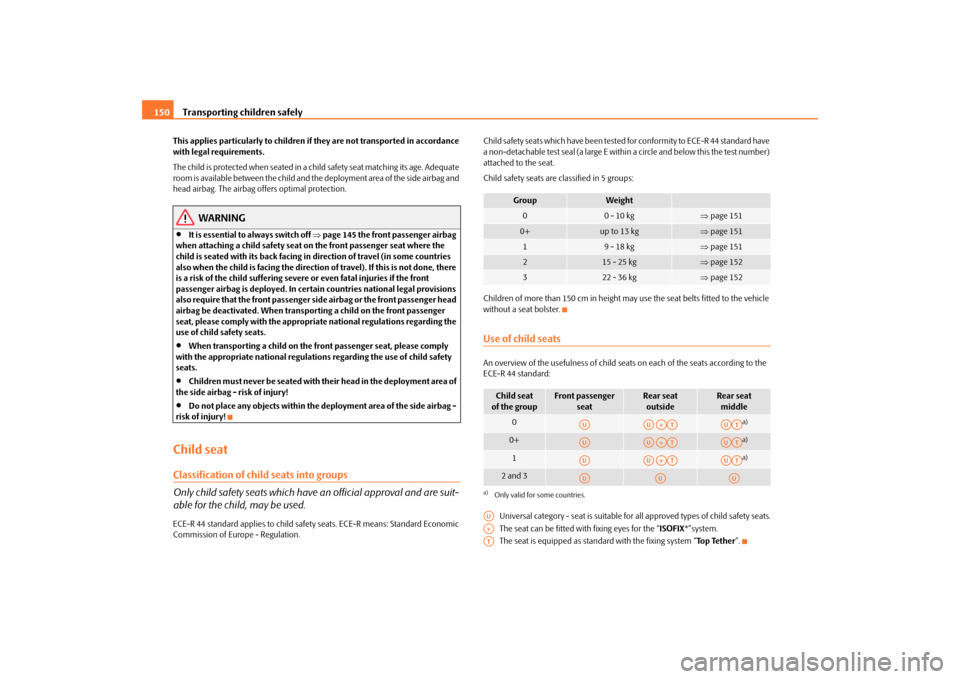
Transporting children safely 150This applies particularly to children if they are not transported in accordance
with legal requirements.
The child is protected when seated in a child safety seat matching its age. Adequate
room is available between the child and the deployment area of the side airbag and
head airbag. The airbag offers optimal protection.
WARNING
•
It is essential to always switch off ⇒page 145 the front passenger airbag
when attaching a child safety seat on the front passenger seat where the
child is seated with its back facing in direction of travel (in some countries
also when the child is facing the direction of travel). If this is not done, there
is a risk of the child suffering severe or even fatal injuries if the front
passenger airbag is deployed. In certain countries national legal provisions
also require that the front passenger side airbag or the front passenger head
airbag be deactivated. When transporting a child on the front passenger
seat, please comply with the appropriate national regulations regarding the
use of child safety seats.
•
When transporting a child on the front passenger seat, please comply
with the appropriate national regulations regarding the use of child safety
seats.
•
Children must never be seated with their head in the deployment area of
the side airbag - risk of injury!
•
Do not place any objects within the deployment area of the side airbag -
risk of injury!
Child seatClassification of child seats into groups
Only child safety seats which have an official approval and are suit-
able for the child, may be used.ECE-R 44 standard applies to child safety seats. ECE-R means: Standard Economic
Commission of Europe - Regulation.Child safety seats which have been tested for conformity to ECE-R 44 standard have
a non-detachable test seal (a large E within a circle and below this the test number)
attached to the seat.
Child safety seats are classified in 5 groups:
Children of more than 150 cm in height may use the seat belts fitted to the vehicle
without a seat bolster.
Use of child seatsAn overview of the usefulness of child seats on each of the seats according to the
ECE-R 44 standard:
Universal category - seat is suitable for all approved types of child safety seats.
The seat can be fitted with fixing eyes for the “ISOFIX*”system.
The seat is equipped as standard with the fixing system “To p Te t h e r”.
Group
Weight
0
0 - 10 kg
⇒page 151
0+
up to 13 kg
⇒page 151
1
9 - 18 kg
⇒page 151
2
15 - 25 kg
⇒page 152
3
22 - 36 kg
⇒page 152
Child seat
of the group
Front passenger
seat
Rear seat
outside
Rear seat
middle
0
a)
a)Only valid for some countries.
0+
a)
1
a)
2 and 3
AU
AUA+AT
AUAT
AU
AUA+AT
AUAT
AU
AUA+AT
AUAT
AU
AU
AU
AUA+AT
s29g.4.book Page 150 Wednesday, June 17, 2009 9:54 AM